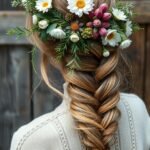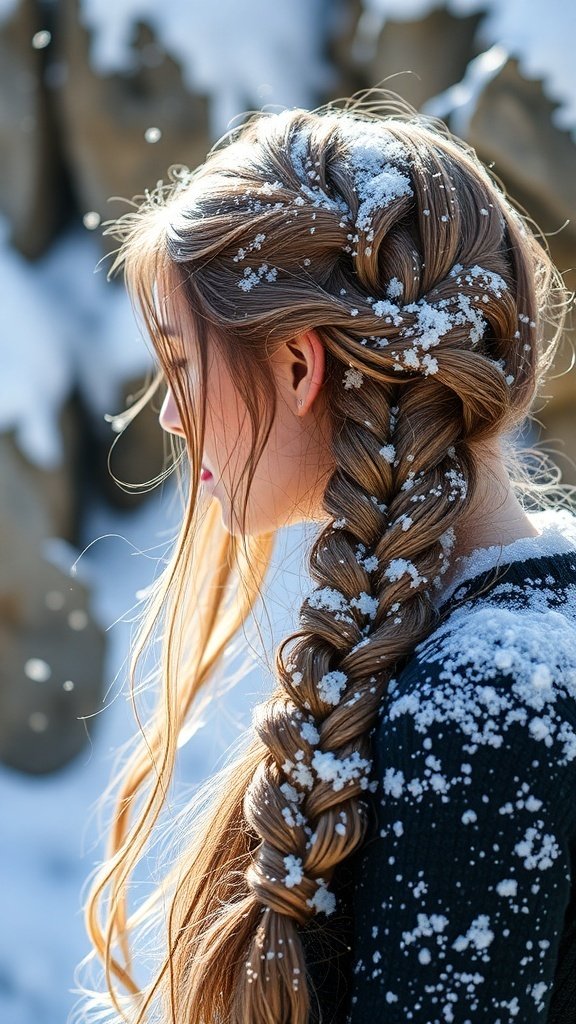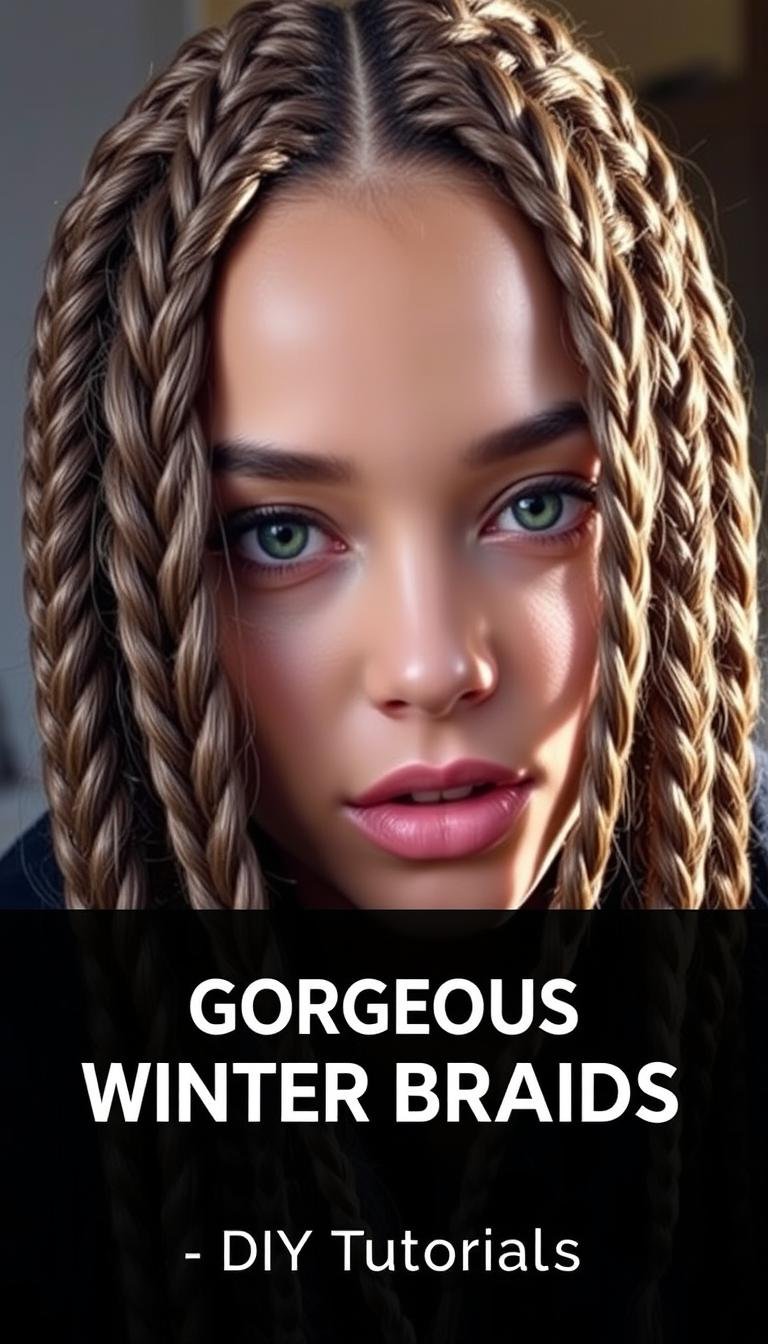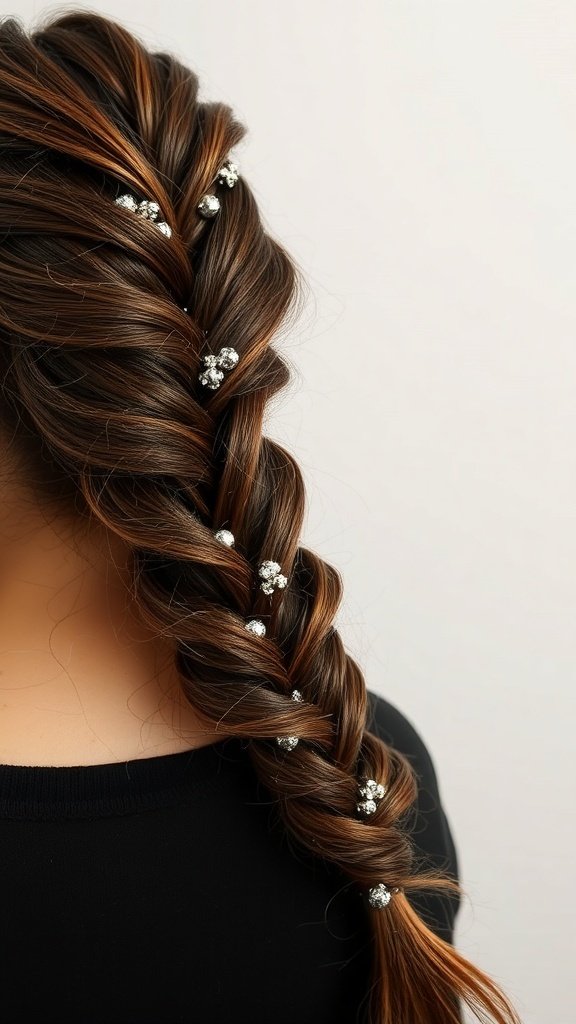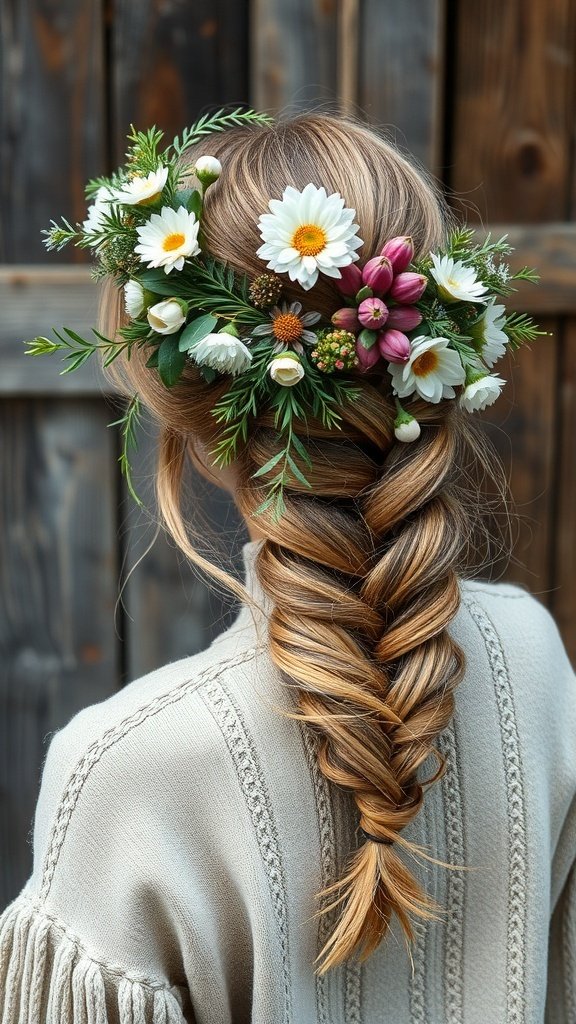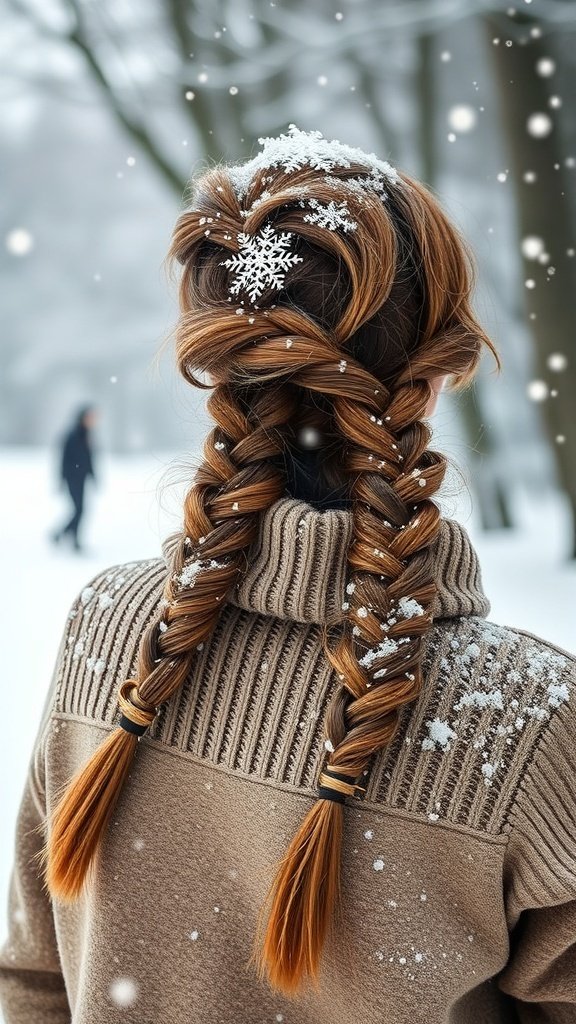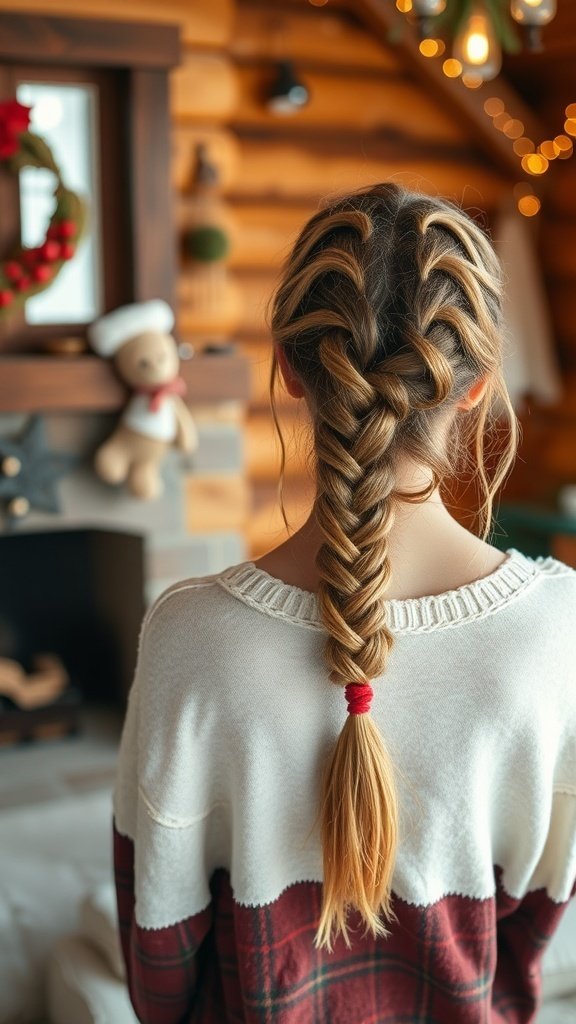Nearly 70% of people in snowy U.S. areas say their hair breaks more in winter. This makes picking the right styles key for warmth and hair health.
Welcome to your Step-by-Step Winter Hair Braid Tutorials. This guide shows you how to braid in winter. It helps keep your hair healthy and looking good all season.
This article has tutorials for French, Dutch, fishtail, and updo braids for winter. You’ll learn how to prepare, what products to use, and the tools you need. These include a wide-tooth comb, detangling brush, and silk bonnet.
These tutorials are great for anyone, whether you’re commuting, parenting, or going to holiday events. They’re fast and look great. Each braid has tips for wearing hats, scarves, and layered outfits. Plus, there’s advice for different hair types and lengths.
Key Takeaways
- Step-by-Step Winter Hair Braid Tutorials provide protective, stylish options for cold climates.
- Prep with moisturizers, leave-in conditioners, and light oils to reduce winter breakage.
- Use the right tools: wide-tooth comb, detangling brush, sectioning clips, and silk accessories.
- Choose braid tension based on hair type to balance protection and comfort under hats.
- The guide includes quick morning looks and polished updos for holiday events.
Why Choose Braids for Winter Hairstyles
Braids are great when it gets cold. They keep your hair in place and protect it from dry air. This is good for anyone dealing with indoor heat or windy days.
Benefits for hair health in cold weather
Braids shield your hair from harsh winds and dry air. They also cut down on hair breakage from styling. Use a moisturizing product like SheaMoisture or Olaplex No.7 to keep your hair healthy.
Practicality for hats, scarves, and layers
Flat braids fit under hats without making them look big. Styles like braided buns work well under scarves and coats. Braids also stop tangles and static when you wear layers.
Versatility for casual and formal winter events
Braids are perfect for any winter event. A simple side braid is great for busy mornings. For fancy events, add clips or ribbons to your braid. This makes braids a top choice for winter.
Preparing Hair for Winter Braiding
Start with a gentle hair routine for winter. This keeps hair hydrated and easy to braid. Use special products and steps to make braids last longer and keep your scalp healthy.
Moisturizing and protective products
Use sulfate-free shampoos and rich conditioners. Brands like SheaMoisture or Briogeo are good. Then, apply a leave-in product like Kinky-Curly Knot Today or It’s a 10 Miracle Leave-In for extra slip.
Use lightweight styling creams to tame frizz. Seal ends with argan, jojoba, or coconut oil to keep moisture in. Spray a heat protectant like HSI Professional or TRESemmé Thermal Creations before heat styling.
Detangling techniques to prevent breakage
Detangle on wet or damp hair with conditioner. Use a wide-tooth comb or Wet Brush to avoid snags.
Start detangling from the ends and work up. Use clips to keep sections smooth. Trim split ends before braiding to prevent breakage.
Tools and accessories you’ll need
Get the right tools for quick styling. You’ll need a wide-tooth comb, rattail comb, and sectioning clips.
Have snag-free elastics, strong bobby pins, and small clear elastics ready. Use texturizing spray and dry shampoo for extra grip. Keep satin scrunchies and a silk or satin bonnet or pillowcase for protection.
For finishing, have decorative pins or ribbons. These make styling faster and protect your hair.
Step-by-Step Winter Hair Braid Tutorials
Here’s a quick guide to help you find the right braid tutorial. It covers the difficulty level, how to set up your braid base, and common mistakes to avoid.
Overview of difficulty levels
Beginner braids are easy and quick. Try simple side braids or half-up braids. They take about 5–10 minutes to look great.
Intermediate styles like French braids and basic fishtails take 15–30 minutes. You’ll get better at making them neat and tight.
Advanced braids, like crown Dutch braids, need 30–60 minutes. They require more practice and careful hand placement.
Preparing base styles for each tutorial
Choose the right braid base for your look. Use a light conditioner or gel on damp hair for sleek looks. Add a texturizer to dry hair for volume.
Use a rattail comb for clean parts. Smooth flyaways with styling cream. Blow-dry for hold or braid on damp hair for soft edges.
Section hair for multi-strand braids. Keep your hands steady to avoid tangles.
Common mistakes to avoid
Don’t braid slippery hair; it leads to loose braids. Avoid tight braids to prevent hair loss.
Use soft elastics and avoid metal ties. Fix uneven braids by reworking sections, not tightening.
Stop and rebalance if tension varies. Practice small sections and keep hands steady to avoid mistakes.
| Skill Level | Example Styles | Time Range | Prep Tips | Common Pitfalls |
|---|---|---|---|---|
| Beginner | Side braid, half-up braid | 5–10 minutes | Light leave-in, clean parting | Uneven sections, loose ends |
| Intermediate | French braid, basic fishtail | 15–30 minutes | Blow-dry or braid on damp hair, texturizer | Inconsistent tension, sloppy edges |
| Advanced | Crown Dutch braid, braided chignon | 30–60 minutes | Precise sectioning, smoothing cream | Over-tightening, insufficient anchors |
Classic French Braid Tutorial for Cold Days
Cold weather means we need styles that stay neat and comfy under hats. This guide helps you learn the French braid. It’s great for all hair types.
Sectioning and tension tips for thicker layers
Begin with small parts for layered or thick hair. This keeps short layers in and prevents ends from showing. Use a brush to guide each piece into the braid.
Make sure to pull strands evenly. Don’t pull too hard, as it can hurt. For heavy hair, try two side braids or a big center braid.
Ways to secure and style under hats
Place braids low at the back for a flat look under hats. Two braids meeting in a loop is a neat trick. Use flat elastics to avoid bulk at the crown.
To fit bulky hats, flatten the braid by pulling the edges out. Tuck the ends under the braid or into a low bun for a smooth look.
Finishing sprays and softening products
Use a hairspray like L’Oréal Elnett or Bumble and bumble Invisible Oil Finishing Spray. It keeps flyaways away without making the braid stiff. Add argan oil or Verb Ghost Oil on ends for shine and softness.
For a natural look, use texturizing spray lightly. It adds body and keeps the style fresh. A light mist and gentle touch keep it looking good.
| Step | What to Do | Product or Tool |
|---|---|---|
| 1 | Detangle and smooth sections for clean starts | Wide-tooth comb, smoothing brush |
| 2 | Create small subsections on layered hair to trap short pieces | Fine-tooth tail comb |
| 3 | Maintain even tension; pull firmly, not tight | No product needed, focus on hand placement |
| 4 | Secure braid low and tuck ends for hat-friendly shape | Flat elastics, bobby pins |
| 5 | Finish with flexible-hold spray and a light oil for shine | L’Oréal Elnett or Bumble and bumble spray, argan oil or Verb Ghost Oil |
Dutch Braid Variations for Warmth and Style
Dutch braids add texture and warmth to winter outfits. This guide shows how to do an inverted braid for extra lift. It also teaches a wrapped braid for formal events and a neat bun for cold days.
Inverted braid volume
Start with a Dutch braid that crosses strands under, not over. This makes a braid that sits on top of your hair. For more volume, gently backcomb the crown before braiding.
Then, pancake the braid by pulling at the edges. Finish with hairspray to keep it looking great under hats.
Crown for winter occasions
Make a braid around your hairline to create a crown. Use the Dutch method for a bold look. Pin the ends at the nape or behind the ear.
Use a smoothing serum for shine. Add metallic pins or pearl clips for a fancy look at parties.
Dutch braid bun
Braid two Dutch braids from the temples or along part lines. Then, wrap them into a low bun at the nape. Secure with pins for a neat look under scarves.
This bun keeps your hair safe from wind and looks professional. Use small elastics and hidden bobby pins for a clean look all day.
Fishtail Braid Looks That Withstand Winter Weather
Fishtail styles keep hair neat and warm. They look polished for holiday plans. This guide shows how to do a classic fishtail, add texture for a messy look, and add sparkle with accessories.
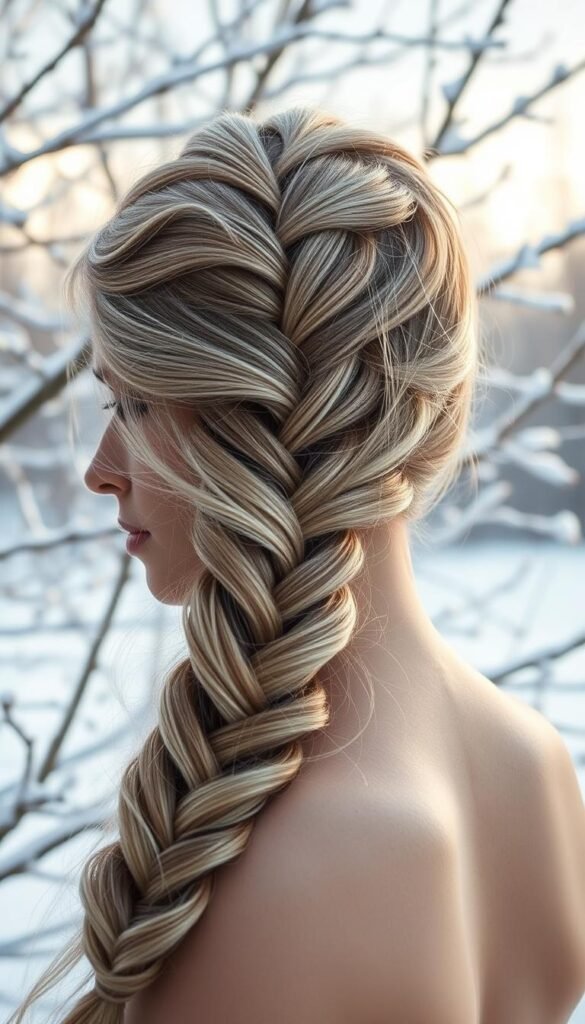
Creating a full fishtail on medium to long hair
Start with detangled, slightly textured hair. Divide into two even sections. From the outer edge of the right section, take a small strand and cross it over to join the left section. Repeat on the left, alternating small strands and keeping motion steady down the length. Secure the end with a small clear elastic.
For a full-length winter fishtail, begin the braid at the crown. For a half style, start lower near the nape. Smooth a pea-sized amount of styling cream along the braid to tame flyaways and add gentle hold.
Texturizing tips for a cozy, messy finish
Spritz a salt spray or dry texturizing mist before braiding. This helps the braid hold in damp cold air and creates that lived-in look.
After you braid, pancake the braid by gently pulling at the outer edges for width and softness. For fine hair, tease lightly at the crown to lift the root area and make the messy fishtail appear fuller.
How to add accessories for holiday flair
Weave a velvet ribbon through a fishtail for daytime charm, matching coat textures for a polished outfit. For evening, tuck a decorative comb near the braid’s start or pin tiny Swarovski-style clips along the tail for subtle sparkle.
Small festive pins work well on beanie days because they sit flat and won’t catch on scarves. Keep a pack of neutral clear elastics and a couple of elegant clips in your bag for quick touch-ups and seasonal looks with fishtail accessories.
Protective Braids to Prevent Winter Damage
Protective braids are great for cold months. They help when hair gets dry and you wear hats a lot. They keep your hair and scalp happy while you wear braids in winter.
Choose looser braids to avoid hair damage. They are better for your hair. Be gentle when you make your braids, but still look neat.
For active days, you might want a bit tighter braid. But, make sure it’s not too tight. This keeps your hair healthy.
Nighttime care and silk/satin protection
Start your nighttime braid care with a silk or satin pillowcase. These fabrics are soft and keep your hair moist.
Before bed, lightly spray your braids with a leave-in conditioner. Then, apply a thin layer of oil to keep your hair hydrated. Slip and other brands have great silk accessories.
Scalp care while wearing protective styles
Keep your scalp clean and moisturized while wearing braids. Use a light oil, like jojoba, to keep it soft. This prevents dryness.
Scalp massages are good for you. They help your scalp breathe and stay healthy. If your scalp gets itchy, use an anti-itch spray. Take breaks from braids to let your scalp rest.
Quick Everyday Braids for Busy Winter Mornings
Short winter mornings need quick hair styles. These ideas keep hair neat and warm fast. They’re perfect for busy mornings.

Simple side braids and twists
Start with a deep side part. Gather a front section and braid a simple side braid. Finish by tucking the end under a scarf or beanie.
For a quicker option, try a two-strand twist. Split a section, twist each piece, then wrap them around each other. Secure with a clear elastic. These can be done in 3–5 minutes.
Half-up braided looks that take minutes
Create a face-framing half-up by French braiding or fishtailing a small front section. A double mini-braid on each side joined with a clip gives a polished finish. These styles are quick and stylish, perfect for rushed mornings.
Time-saving tips and product shortcuts
Prep hair the night before by loosely braiding damp hair. This adds texture and reduces morning heat styling. Keep a travel kit with a multi-use leave-in, a compact brush, and a serum.
Use pre-sectioned clips to speed up parting. Fasten elastics that slide on easily. These tips help you make fast winter braids without extra steps.
Braided Updos for Holiday Parties and Events
Get ready for the season with stylish updos. They’re perfect for weddings, office parties, or family dinners. You can make these looks at home with simple tools and festive accessories.
Romantic braided bun tutorial
Begin with a loose French or Dutch braid at the crown. Make sure it’s soft. Then, gather it into a ponytail and twist it into a bun.
Secure with bobby pins. Pull out a few strands for a romantic look. Finish with a texturizing spray for winter.
Low braided chignon for cold-weather outfits
Make a single braid at the back of your neck. It’s great under scarves and high collars. Wrap it into a tight chignon and pin it down.
Use angled bobby pins for a flat look. Smooth flyaways with serum for a neat style.
Adding sparkle: pins, clips, and ribbons
Use pearl pins, rhinestone clips, or metallic combs for sparkle. Tuck pins around the bun for extra hold. Add a statement clip to match your jewelry.
For a softer look, weave a velvet or satin ribbon through the braid. Choose colors that match the season.
Braids for Different Hair Types and Lengths
Choose braid styles based on your hair’s texture and length. This will help you get the best look and hold. Making small changes in products and techniques can make a big difference.
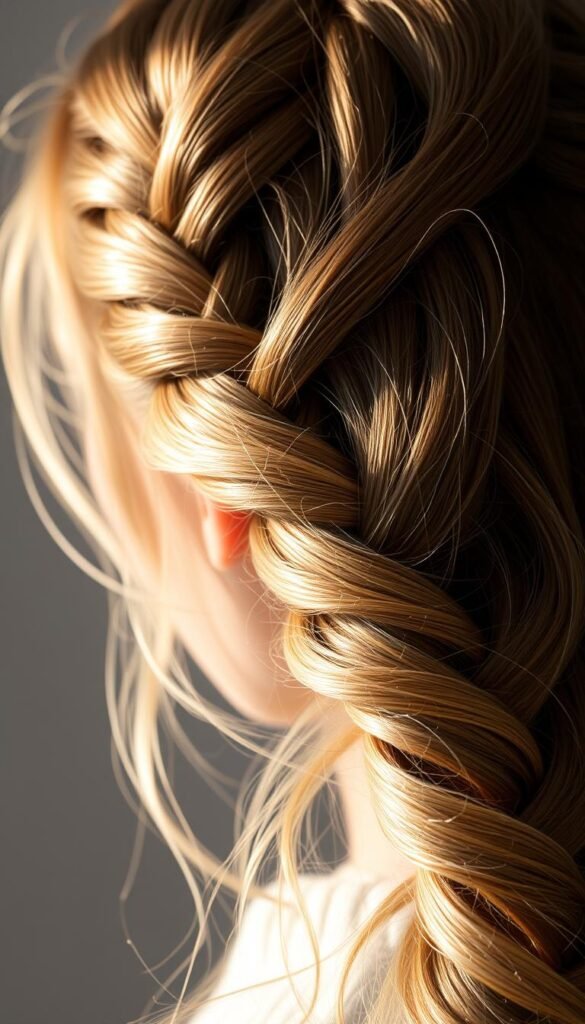
Techniques for fine and thin hair
Start with a root-lifting mousse or dry shampoo to add grip. Backcomb lightly at the crown for volume. Use smaller subsections for fishtail braids to make them fuller.
Then, gently pancake the sides for width. Clip-in extensions or a halo braid add density for styles needing more presence.
Working with thick or curly hair textures
Detangle with conditioner and a wide-tooth comb to protect curls. Braiding on damp hair smooths the surface and reduces frizz. Use thicker elastics and strong pins to keep shapes secure.
Apply a curl cream like SheaMoisture Curl Enhancing Smoothie before braiding. This enhances definition in curly hair and adds polish when pancaking for volume.
Adapting braids for short hair
Adapt braids for short hair with mini Dutch braids along the hairline. Try braided headbands and partial braids that end in pinned twists. Use small elastics and sturdy bobby pins to hold shorter lengths.
For very short styles, fake a braid by twisting small sections and pinning them flat. This creates a faux-braid effect that looks intricate without needing long lengths.
Maintaining Braids During the Winter Season
Winter means cozy layers and special braid care. Use light steps to keep hair moist and healthy. Small daily actions protect your braids and scalp in cold, dry weather.
Daily maintenance and refreshing techniques
For quick braid refresh, mist with a light spray or diluted conditioner. Use a small gel to smooth flyaways and tighten loose ends. Sleep on silk to reduce hair damage and re-pancake braids each morning.
Product recommendations for longevity and moisture
Choose products that keep braids hydrated and protect your scalp. Use It’s a 10 Miracle Leave-In for conditioning and argan or jojoba oil to seal ends. Anti-frizz serums help with winter static. Oribe Serene Scalp and dry shampoo keep braids clean without disturbing them.
For deeper care, apply Briogeo Don’t Despair, Repair on washed hair before braiding. Regular trims prevent split ends from moving up the hair.
When to take braids down to prevent damage
Watch for signs it’s time to remove braids. Most styles last 4–6 weeks. Natural textures may need removal sooner, often between 2–8 weeks. Remove braids if you see matting, excessive shedding, or itching.
After long braids, take a break with deep hydration and gentle detangling. For winter braid ideas and styling with accessories, see this cozy braid gallery at winter braid inspiration.
Styling Inspiration and Real-Life Photo Ideas
Find new braid ideas for winter clothes. Start with simple pairs that keep hair tidy and let accessories stand out. Use pictures to help place braids with big coats or hats.
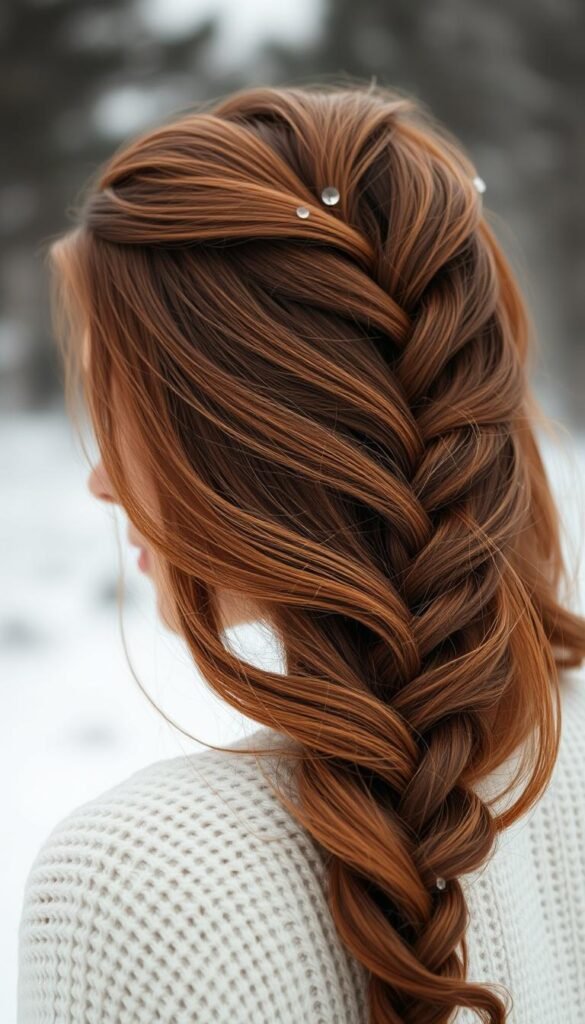
Combining braids with winter accessories
Low buns and side braids are great under beanies and earmuffs. Crown braids are perfect with open-collar coats. Fishtails are festive with ribbon through the weave for special events.
Match accessory size to braid placement. Thick scarves go with loose, chunky braids. Slim scarves fit tighter styles for a clean look.
Seasonal color accents and highlights
Add seasonal hair accents that pop in photos without long-term commitment. Clip-in highlights or colored ribbon woven into a braid brighten holiday looks. Colored hair chalks are fun for a night out.
Subtle balayage or lowlights enhance braid texture while staying wearable. Test temporary colors on a small section before weaving them into an entire style.
Saving and organizing looks for reference
Build a visual library of braided looks photos for quick inspiration. Use Pinterest boards, Instagram collections, or a dedicated phone folder to store favorites. Tag each image with products and tools used.
Create a simple checklist for each saved tutorial: prep product, tools needed, and estimated time. That routine makes it easier to recreate complex styles on busy mornings.
Conclusion
Braids are great for keeping hair safe and looking good. They protect hair from cold and reduce damage from hats and scarves. They are perfect for busy mornings or special nights.
There are many braids to try, like French, Dutch, fishtail, and updos. These braids fit different hair lengths and types. Start with easy ones and use gentle products to keep hair healthy.
Don’t forget to take care of your scalp and use satin or silk at night. This helps your braids last longer. You can also use clips and ribbons to change your look.
Try one braiding tutorial this week and save your favorite looks. Share your braids on social media to inspire others. Always be careful not to pull too hard on your hair.
Give your hair breaks from braids to keep it growing well. Keep practicing and taking care of your hair. This way, your hair will stay strong and stylish all winter.



